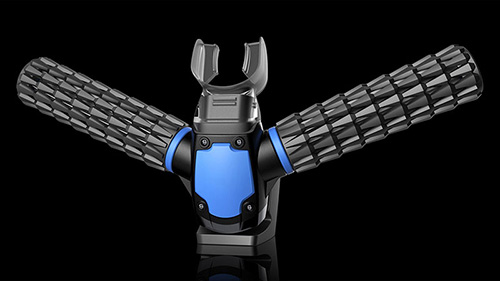Was This a Million Dollar Scam?Contents of this Issue: Sonny Dive Shop, Isla de Providencia, Colombia Sperm Whales Killed by Plastic Fish & Fins, Palau Aggressor, Micronesia Most Dangerous Inland America Dive Sites? Was This a Million Dollar Scam? Australia’s Great Barrier Reef Controversy When They Steal Your Photos from the Web Borrow an Image? It Will Cost You! Snorkler Mauled to Death in Raja Ampat by a Dinosaur Travel Agent v Internet - Part III Effective Product to Stop Dangerous Jellyfish Stings Win a Tropical Dive Resort? Or Not. Editorial Office: Ben Davison Publisher and Editor Undercurrent 3020 Bridgeway, Suite 102 Sausalito, CA 94965 an investment opportunity for the gullible from the May, 2016 issue of Undercurrent
In Thunderball and Die Another Day, James Bond dived with a mouthpiece fed by what looked like a little CO2 cartridge, but they were movies. Some time ago, the Internet carried stories of a device a diver could hold in his mouth that would enable breathing underwater without the aid of a tank. It resembled a regulator mouthpiece with bicycle handlebar grips attached at both sides. It was called Triton and was initially a mocked-up design concept of a college student.
In August 2014, Undercurrent published a piece entitled "There's Something Fishy About This Dive Gear," pointing out that the device made no sense. However, American dive magazines pretty much ignored it -- why alienate a potential advertiser? -- and through mid-March of this year, the developers had raised nearly $900,000 from website crowd funding via Indiegogo. Regardless, just a few days ago we again warned our readers to stay away. But, was Undercurrent's appraisal wrong? Is this device about to revolutionize the dive market? A little history. Years ago, the UK's Diver Magazine investigated the claims of an Israeli inventor who had come up with a device that could release and collect oxygen dissolved in the water, rather like the gills of a fish, and provide enough oxygen to sustain a human being under water. Professor Emeritus Felix Weinberg (University of London) countered the claim, saying that the electrical power needed would require the diver to be tethered to a small power station. Nonetheless, the Triton project was created and has captured the imagination (or is it the gullibility?) of more than 1400 people, who poured money into their Indiegogo crowd funding site. Presumably, they were not the Undercurrent readers we had warned. "With Triton, there's no heavy equipment, complicated safety procedures or training. It's easy to use, and no longer than a snorkel," Triton founders Saeed Khademi and Jeabyun Yeon claimed on their Indiegogo page. "Gently bite into the mouthpiece, breathe normally, and enjoy a sense of underwater freedom unavailable until now. Just imagine exploring gin-clear waters, alongside tropical fish, without bulky equipment or having to surface for air." Saeed Khademi (also known as Reza) is Iranian, lives in Sweden and worked for Warner Music. Jeabyun Yeon is a young design student at the Samsung Art & Design Institute and lives in Seoul, South Korea. Since neither looks to have the chops to create such a device, we tried to contact both, but neither responded. Represented by pictures looking suspiciously identical to the student's design concept, the artificial gills were claimed to be made with a microporous hollow fiber, which are lined with tiny holes that allow oxygen collected to pass through. The website claims that users can dive for 45 minutes at fifteen feet. Time would be limited because the device, as claimed, has a micro compressor powered by a micro battery, claimed to be 30 times smaller than anything currently available -- wouldn't Apple love that -- and able to be charged a thousand times faster. James Bond? No, more like Star Trek! For an average person, it would need to pass more than seven gallons of seawater per minute to provide sufficient oxygen for each single breath. It would need to process more than 30 times that amount to allow a typical adult to breathe for one minute at the surface. Their short video provided "evidence" that they have a working prototype, but it showed a person swimming with it for the time that you or I could do an unchallenging breath-hold dive. According to physicists, there is far too little dissolved gas in water to allow the principle to work in any real way. Furthermore, what happens to the poisonous carbon dioxide exhaled? On April 4, it was reported by the British Daily Mail, the International Business Times and CNBC that Triton would refund nearly $900,000 raised in crowd funding through Indiegogo. Undaunted, the principals of Triton have relaunched with an equally implausible explanation of how the Triton Gills might work, now using a small cylinder of liquid oxygen with refills of this rocket fuel to be available via the Internet. At the time of writing they have already had more than $250,000 re-invested! |

I want to get all the stories! Tell me how I can become an Undercurrent Online Member and get online access to all the articles of Undercurrent as well as thousands of first hand reports on dive operations world-wide
| Home | Online Members Area | My Account |
Login
|
Join
|
| Travel Index |
Dive Resort & Liveaboard Reviews
|
Featured Reports
|
Recent
Issues
|
Back Issues
|
|
Dive Gear
Index
|
Health/Safety Index
|
Environment & Misc.
Index
|
Seasonal Planner
|
Blogs
|
Free Articles
|
Book Picks
|
News
|
|
Special Offers
|
RSS
|
FAQ
|
About Us
|
Contact Us
|
Links
|
3020 Bridgeway, Ste 102, Sausalito, Ca 94965
All rights reserved.


